13 Coffee Trees Growing in the Coffee BeltThe 13 coffee trees found in the world are Coffea Arabica, Coffea Canephora (Robusta), Coffea Liberica, Coffea Excelsa, Coffea Stenophylla, Coffea Eugenioides, Coffea Mauritiana, Coffea racemosa, Coffea Congensis, Coffea Charrieriana, Coffea Anthonyi, Coffea Brevidiscus, and Coffea Gallienii. Each tree species has its own unique characteristics and contributes to the diverse flavors and profiles of coffee worldwide.
1. Coffea Arabica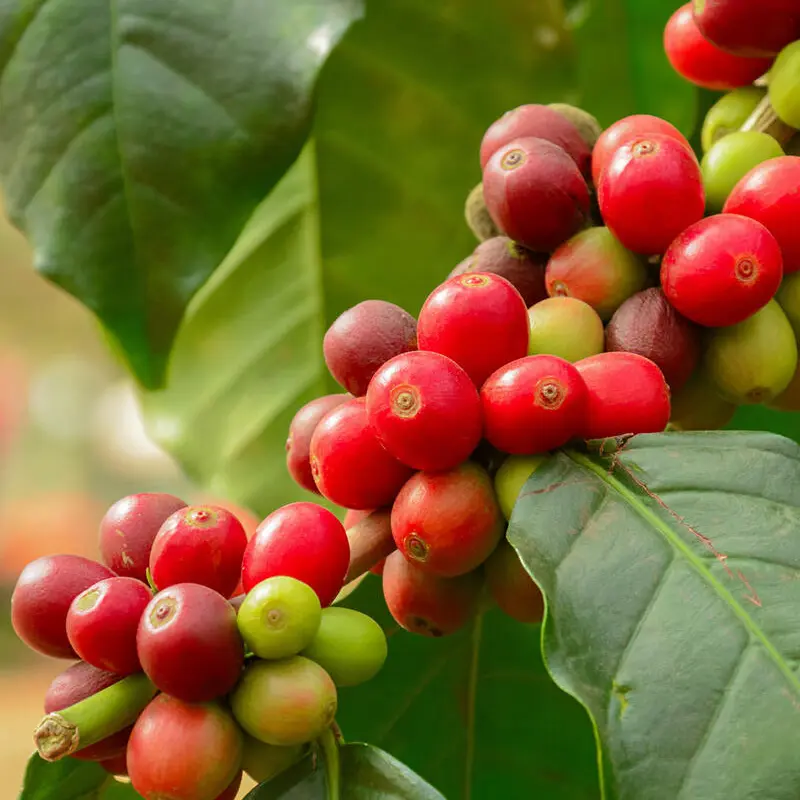 - Height: 6.5 to 39 feet- Cherry: 2 seeds, bright red to purple color- Caffeine content: 1.61g/100g- **Sugar content: **6-9%- Flavor profile: Flavorful and aromatic - **Origin: **Southern Ethiopia and Yemen- Adopted/Growing region: All coffee-growing regions- Growing altitude: 2000 to 6,500 feet- Growth period: 3-4 years- Crop-producing period: 30-50 years- Global market share: 70%
- Height: 6.5 to 39 feet- Cherry: 2 seeds, bright red to purple color- Caffeine content: 1.61g/100g- **Sugar content: **6-9%- Flavor profile: Flavorful and aromatic - **Origin: **Southern Ethiopia and Yemen- Adopted/Growing region: All coffee-growing regions- Growing altitude: 2000 to 6,500 feet- Growth period: 3-4 years- Crop-producing period: 30-50 years- Global market share: 70%
The Coffea Arabica or simply Arabica coffee or Arabic coffee is a small, dwarf-like flowering coffee tree in the Rubiaceae family. Growing to about 6.5 to 39 feet tall, the Arabica coffee tree accounts for the majority of global coffee production. Arabica coffee is endemic to South Ethiopian and Yemeni forests, explaining its name.
However, the tree has been adapted to various regions and can be found across all coffee-growing regions today. In fact, the latest adoption of Arabica coffee trees was in the 80s to 90s in southern Australia, where it is grown today.
Upon maturity, Coffea Arabica trees produce the coffee cherry that develops bright red to purple color and bears two seeds inside. On the other hand, the tree takes about three to four years to mature and produce its first crop. However, they can yield the coffee crop for up to 50 years, with the yield significantly decreasing after 30 years.
When brewed, Arabica coffee beans produce a more flavorful and aromatic coffee with less acidity and bitterness. Arabica coffee beans usually contain around 6 mg of caffeine per bean.
2. Coffea Canephora (Robusta)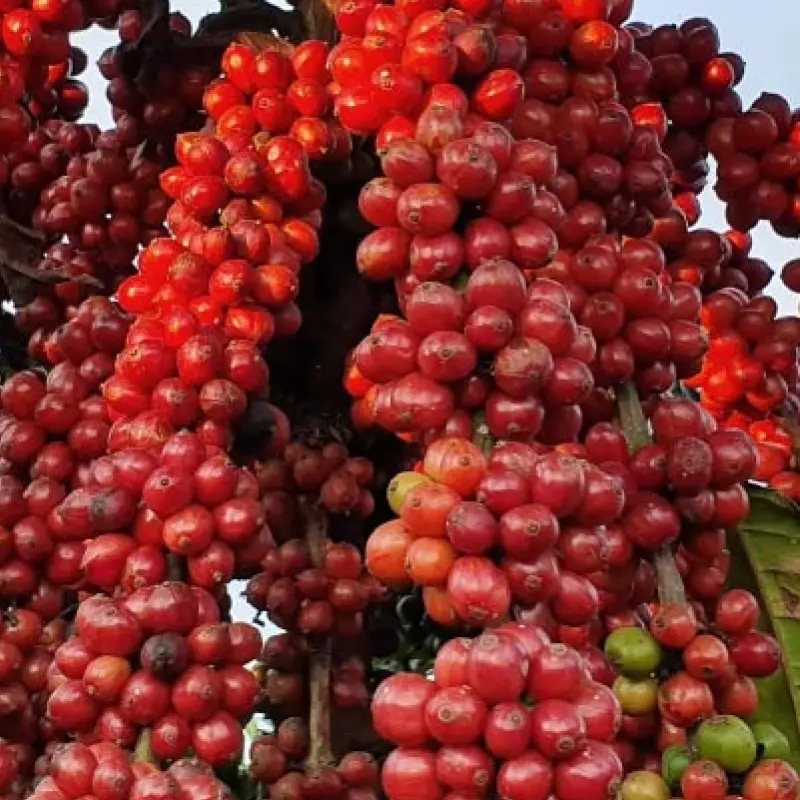 - Height: 33 feet- Cherry characteristics: Rounder and smaller rich and dark red cherry with 2 seeds- Caffeine content: 2.26g/100g- **Sugar content: **3-7%- Flavor profile: Woody and earthy- Origin: Central and Western sub-Saharan Africa- Adopted/Growing region: Central and western sub-Saharan Africa, Americas, and Asia- Growing altitude: 600 to 2,400 feet- Growth period: 3-4 years- Crop-producing period: 30-50 years- Global market share: 30-45%
- Height: 33 feet- Cherry characteristics: Rounder and smaller rich and dark red cherry with 2 seeds- Caffeine content: 2.26g/100g- **Sugar content: **3-7%- Flavor profile: Woody and earthy- Origin: Central and Western sub-Saharan Africa- Adopted/Growing region: Central and western sub-Saharan Africa, Americas, and Asia- Growing altitude: 600 to 2,400 feet- Growth period: 3-4 years- Crop-producing period: 30-50 years- Global market share: 30-45%
Popularly known as robusta, the Coffea canephora tree is the less common coffee tree. The origins of the canephora tree are in central and western sub-Saharan Africa. This explains why areas such as Angola, DRC, Liberia, and Tanzania are still popular robusta coffee growing regions. The canephora variety is believed to be the actual oldest species. It is thought to have merged with other older lesser-known, wild coffee plants to create the Coffea Arabica plant.
Today, the canephora tree has been adopted in coffee-growing regions outside Africa, including the Caribbean, Central America, and Asia. These include countries such as Brazil, Honduras, Peru, Colombia, Jamaica, Costa Rica, Nicaragua, Borneo, French Polynesia, Lesser Antilles, Vietnam, Indonesia, India, and Thailand.
Robusta coffee accounts for about 30% to 45% of the total coffee production globally. Also part of the Rubiaceae family, the canephora tree grows to about 33 feet tall upon maturity. It produces two seeds in its cherry. However, its cherry tends to be smaller and rounder. Further, robusta cherries produce a much richer and darker red color than Arabica. Like the Arabica coffee tree, the canephora tree takes about 3 to 4 years to grow.
Note: The Canephora tree produces two varieties, i.e. Robusta and Ndanda. But, Ndanda is the less commonly known and consumed variety.
When brewed, Robusta coffee beans produce a more woody and earthy coffee with more acidity and bitterness and less fruity undertones. Robusta coffee beans also contain higher caffeine levels, around 10 mg of caffeine per bean. But, they contain significantly less sugar than Arabica, explaining why the coffee isn’t as sweet.
**Fun Fact: **Today, Vietnam is the world’s largest robusta coffee producer, accounting for 40% of the total global robusta coffee production. On the other hand, Brazil and Uganda are the largest Robusta coffee producers in the Americas and Africa, respectively.
3. Coffea Liberica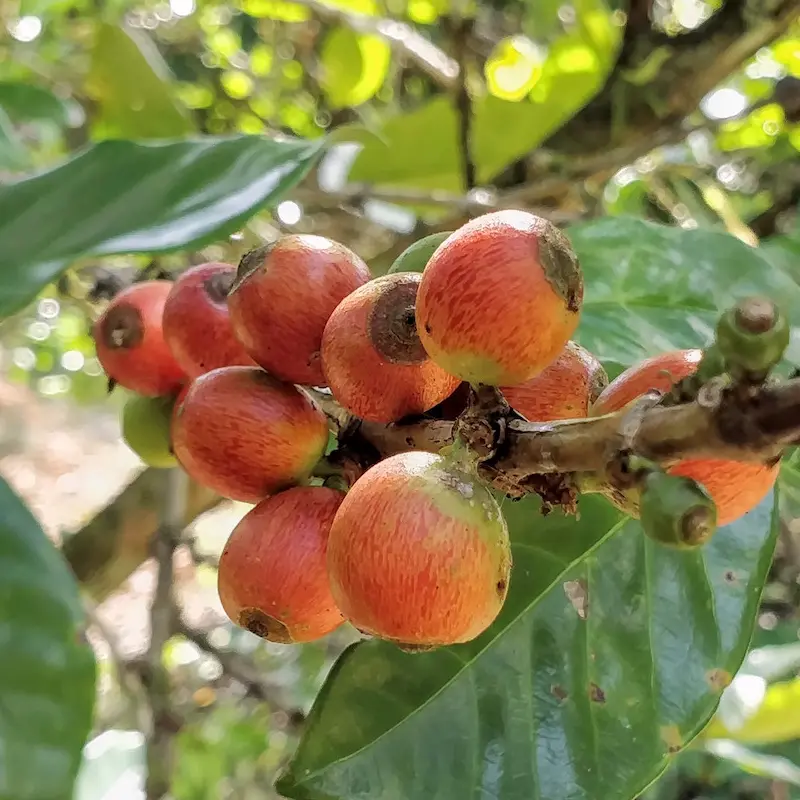 - Height: 66 feet- Cherry characteristics: Bigger and asymmetric shaped with an extended tip with 2 seeds- Caffeine content: 1.23g/100g- **Sugar content: **30%- Flavor profile: Smokey and nutty with dark chocolate, spice, and ripe berry undertones- Origin: Liberia- Adopted/Growing region: Western, East, and Central sub-Saharan Africa, and Asia- Growing altitude: 2,952 to 4,300 feet- Growth period: 5 years- Crop-producing period: 30-50 years- Global market share: 1.5%
- Height: 66 feet- Cherry characteristics: Bigger and asymmetric shaped with an extended tip with 2 seeds- Caffeine content: 1.23g/100g- **Sugar content: **30%- Flavor profile: Smokey and nutty with dark chocolate, spice, and ripe berry undertones- Origin: Liberia- Adopted/Growing region: Western, East, and Central sub-Saharan Africa, and Asia- Growing altitude: 2,952 to 4,300 feet- Growth period: 5 years- Crop-producing period: 30-50 years- Global market share: 1.5%
As the name suggests, Coffea Liberica, or simply Liberica or Liberian coffee is native to central and western sub-Saharan Africa, particularly Liberia. However, you can find it in other parts of Africa, including Angola and Uganda.
Further, Liberica coffee has been adopted outside Africa in Asia. These include Vietnam, the Philippines, Indonesia, and Malaysia. An uncommon variety, coffee liberica only accounts for about 1.5% of global commercial coffee production.
Liberica coffee is among the tallest coffee trees, growing to about 66 feet tall. It is common to harvest coffee using ladders. Liberica beans are also larger than robusta and Arabica. When it comes to the shape, it tends to be asymmetric with one side being longer and the other shorter. Its asymmetric shape also produces an extended bottom tip.
Liberica coffee contains a higher caffeine level than Arabica beans but lower than robusta beans. However, they have significantly higher sugar content, up to 30%. The high sugar content makes the tree a favorite of ants and several pests.
When roasted, liberica beans produce a smoky and nutty flavor profile with dark chocolate, spice, and ripe berry undertones.
Fun Fact: while Liberica was discovered in Liberia. It was first commercially cultivated in the Philippines in the 18th century. The Philippines accounts for more than 70% of the global liberica coffee production today.
4. Coffea Excelsa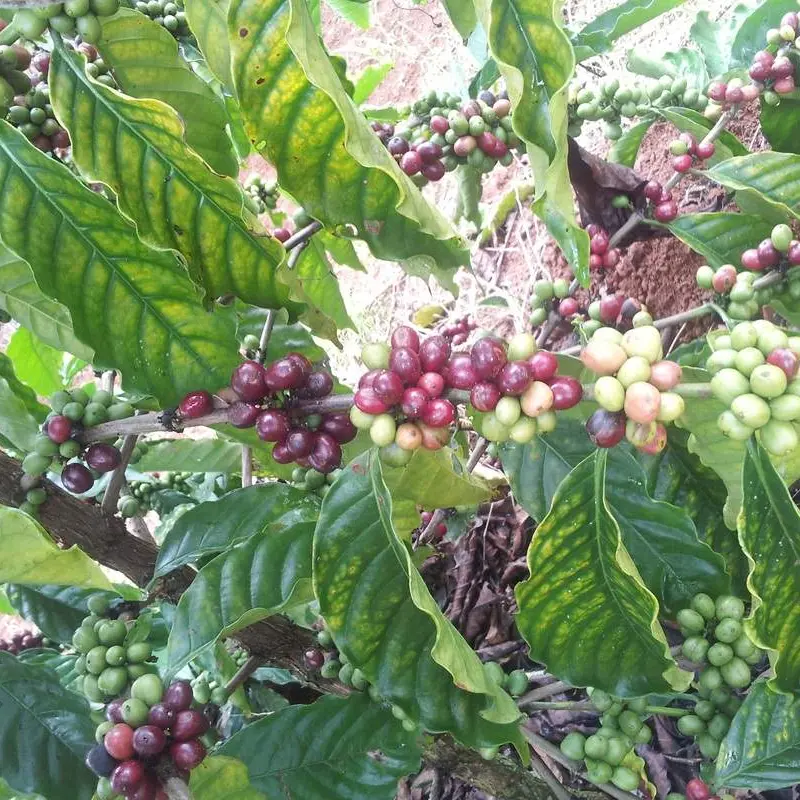 - Height: 50 feet- Cherry characteristics: Small and round with 2 seeds- Caffeine content: 0.86-1.13g/100g- **Sugar content: **30%- Flavor profile: Dark and fruity with some tartness- Origin: Central Africa- Adopted/Growing region: Western, East, and Central sub-Saharan Africa, and Asia- Growing altitude: 3,300 to 4,300 feet- Growth period: 5 years- Crop-producing period: 30-50 years- Global market share: 2%
- Height: 50 feet- Cherry characteristics: Small and round with 2 seeds- Caffeine content: 0.86-1.13g/100g- **Sugar content: **30%- Flavor profile: Dark and fruity with some tartness- Origin: Central Africa- Adopted/Growing region: Western, East, and Central sub-Saharan Africa, and Asia- Growing altitude: 3,300 to 4,300 feet- Growth period: 5 years- Crop-producing period: 30-50 years- Global market share: 2%
The Coffea Excelsa tree is another variety of the Coffea Liberica tree. In fact, this coffee tree is scientifically known as Coffea liberica var. dewevrei. Nonetheless, it is popularly known by its commercial name, Excelsa coffee. In central Africa where it was discovered in the early 20th century, the coffee is known as d dewevrei or dewevreié.
Today, excelsa coffee grows in different western, central, and eastern African countries along with Asian countries, such as Vietnam, the Philippines, and India. Popularly grown in the south East Asian regions, excelsa accounts for 2% of the global commercial coffee production today.
Among coffee lovers, the excelsa tree is known to produce rich flavored coffee. The Coffea excelsa tree grows into a tree, unlike the shrub-like Arabica or robusta plants. So, the plant takes up more vertical space, instead of the horizontal and extended ground area.
Further, excelsa can be a little more difficult to care for. When it comes to the bean, excelsa coffee contains less caffeine than Arabica or robusta. The bean develops a small pronounced round shape and is usually smaller than the liberica bean.
When brewed, excelsa coffee beans produce a unique dark yet, fruity flavor with some tartness. Some coffee drinkers report its flavors to mimic a good scotch.
5. Coffea stenophylla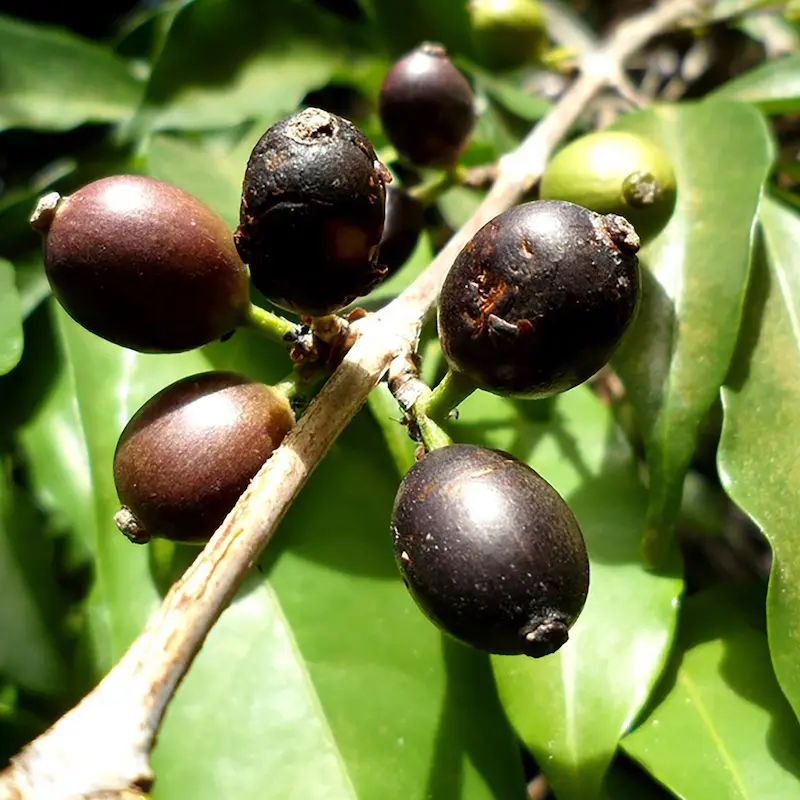 - Height: 20 feet- Cherry characteristics: Dark purple oval with 2 seeds- Caffeine content: 2.05-2.43/100g- **Sugar content: **Unknown- Flavor profile: Naturally sweet with some acidity, fruitiness, and a good mouthfeel- Origin: Sierra Leone- Adopted/Growing region: Sierra Leone, Guinea, Liberia, and Ivory Coast- Growing altitude: 650 to 2,300 feet- Growth period: 3-5 years- Crop-producing period: 30-50 years- Global market share: 0.04%
- Height: 20 feet- Cherry characteristics: Dark purple oval with 2 seeds- Caffeine content: 2.05-2.43/100g- **Sugar content: **Unknown- Flavor profile: Naturally sweet with some acidity, fruitiness, and a good mouthfeel- Origin: Sierra Leone- Adopted/Growing region: Sierra Leone, Guinea, Liberia, and Ivory Coast- Growing altitude: 650 to 2,300 feet- Growth period: 3-5 years- Crop-producing period: 30-50 years- Global market share: 0.04%
Native to Sierra Leone, Coffea Stenophylla, highland coffee or Sierra Leone Coffee is a coffee tree species native to West Africa, more specifically Sierra Leone. The plant traces its cultivation to as early as 1890. This coffee variety has a somewhat special place in the coffee world due to its ability to grow in hot climates.
But, in reality, the coffee isn’t really commercially traded. Instead, it only grows in a small area in the wild in Sierra Leone, Ivory Coast, Guinea, and Liberia. The coffee tree accounts for only 0.04% of global commercial coffee production. Moreover, not much effort is put into introducing it to the market as it produces a relatively smaller yield and smaller berries compared to Arabica and Robusta trees.
The heat-tolerant plant grows as a tree or shrub to about 20 feet. Moreover, the tree typically grows in the highlands with production cycles depending on the rain patterns. According to coffee experts, Stenophylla produces coffee cherries that harvest prized flavors better than Arabica. The problem is that this elusive species isn’t as widely spread.
The limited availability of this plant is also linked to the infamous ’90s Sierra Leone civil war, which saw farmers fleeing their villages and unable to care for the plant for years. This led to the complete elimination of the coffee tree species from commercial and peasant farms. Today, Stenophylla trees are found in forests, growing as wild plants. However, scientists have also introduced trees in contemporary farms to further study their agronomic benefits.
6. Coffea Eugenioides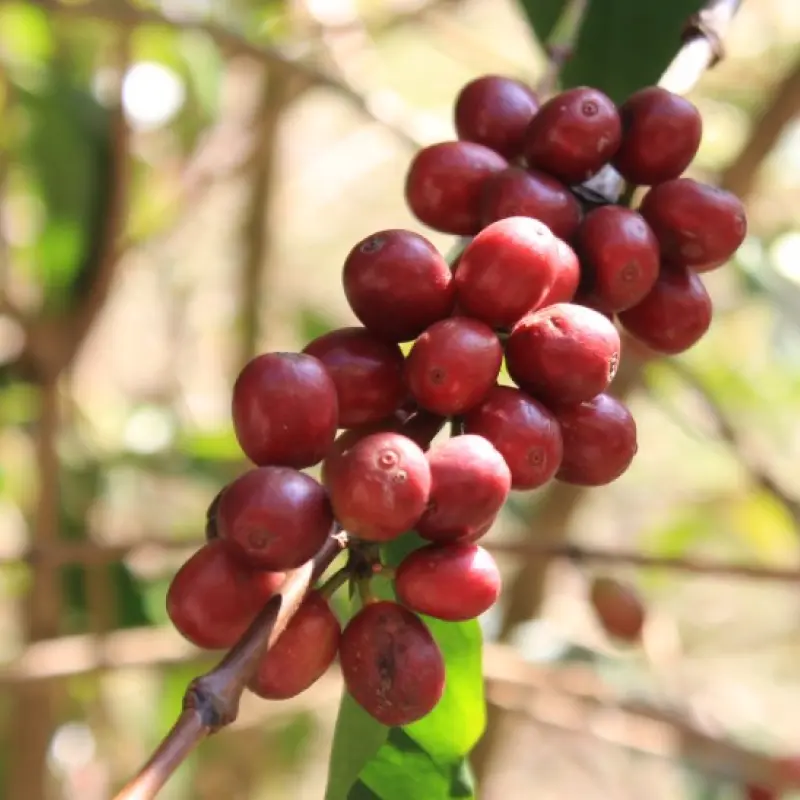 - Height: 6.5 – 10 feet- Cherry characteristics: Deep red, small and oval-shaped with 2 seeds- Caffeine content: 0.3-0.6g/100g- **Sugar content: **Unknown- Flavor profile: Sweet and unusual undertones of cereal milk, lemon drops, toasted marshmallows, and sesame snaps- Origin: East Africa- Adopted/Growing region: East and western Uganda and Colombia- Growing altitude: 6200 to 7545 feet- Growth period: 3-5 years- Crop-producing period: 30-50 years- Global market share: Unknown
- Height: 6.5 – 10 feet- Cherry characteristics: Deep red, small and oval-shaped with 2 seeds- Caffeine content: 0.3-0.6g/100g- **Sugar content: **Unknown- Flavor profile: Sweet and unusual undertones of cereal milk, lemon drops, toasted marshmallows, and sesame snaps- Origin: East Africa- Adopted/Growing region: East and western Uganda and Colombia- Growing altitude: 6200 to 7545 feet- Growth period: 3-5 years- Crop-producing period: 30-50 years- Global market share: Unknown
Coffea Eugenioides is considered the Coffea Arabica parent tree. In fact, according to coffee experts, Coffea Arabica is a hybrid cross of the Coffea Eugenioides and Coffea Canephora (robusta variety). Considered an abandoned species, Eugenioides are extremely rare, but popular in the coffee world for their strange flavors.
It boasts a vibrant profile with sweet and unusual undertones of cereal milk, lemon drops, toasted marshmallows, and sesame snaps. It also has a very low caffeine content, explaining its sweet and mild flavor. It also grows at an unusually high altitude about 6200 to 7545 feet.
The coffee tree plant is native to East Africa in the highlands of DRC, Rwanda, Uganda, Kenya, and western Tanzania. But, not all these countries commercially produce this coffee today. It grows as an understory shrub to a height of about 6.5 to 10 feet.
7. Coffea Mauritiana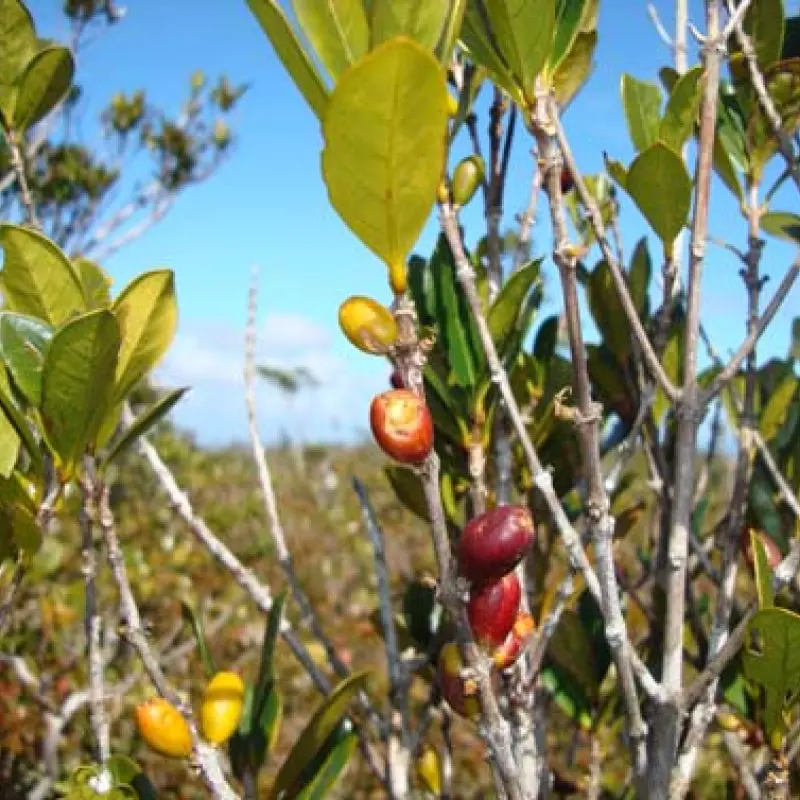 - Height: 6.5 – 10 feet- Cherry characteristics: Round shaped and bright to deep red with two seeds- Caffeine content: Unknown- Sugar content: Unknown- Flavor profile: Unknown - Origin: Mauritius and Reunion** **- Adopted/Growing region: Mauritius, Madagascar, and Reunion- Growing altitude: 650 to 6560 feet- Growth period: Unknown- Crop-producing period: Unknown- Global market share: Unknown
- Height: 6.5 – 10 feet- Cherry characteristics: Round shaped and bright to deep red with two seeds- Caffeine content: Unknown- Sugar content: Unknown- Flavor profile: Unknown - Origin: Mauritius and Reunion** **- Adopted/Growing region: Mauritius, Madagascar, and Reunion- Growing altitude: 650 to 6560 feet- Growth period: Unknown- Crop-producing period: Unknown- Global market share: Unknown
The Coffea Mauritania tree is native to Mauritius and Reunion. However, it also grows in Madagascar. Considered a wild coffee plant, not much is known about this coffee type.
8. Coffea racemosa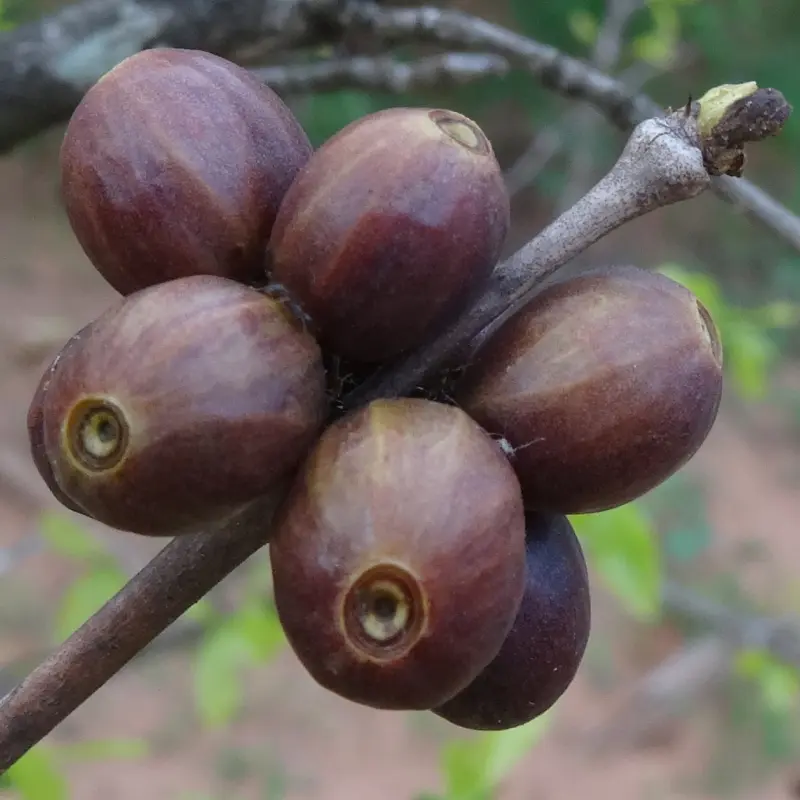 - Height: 11 feet- Cherry characteristics: Round shaped and purple to black with two seeds- Caffeine content: 0.95g/100g- **Sugar content: **40%- Flavor profile: Dry woody and minty flavor with smoky, licorice, and naturally bitter undertones- Origin: Mozambique, Zimbabwe, and South Africa- Adopted/Growing region: Mozambique, Zimbabwe, and South Africa- Growing altitude: 650 to 2000 feet- Growth period: 3 to 5 years- Crop-producing period: up to 50 years- Global market share: Unknown
- Height: 11 feet- Cherry characteristics: Round shaped and purple to black with two seeds- Caffeine content: 0.95g/100g- **Sugar content: **40%- Flavor profile: Dry woody and minty flavor with smoky, licorice, and naturally bitter undertones- Origin: Mozambique, Zimbabwe, and South Africa- Adopted/Growing region: Mozambique, Zimbabwe, and South Africa- Growing altitude: 650 to 2000 feet- Growth period: 3 to 5 years- Crop-producing period: up to 50 years- Global market share: Unknown
Also known as Mozambique coffee, the Coffea racemosa is native to central and southern Mozambique. But, it is also grown in Zimbabwe, and some parts of South Africa. Its wild growth spreads from the coastal forest belt of northern KwaZulu Natal, South Africa to Zimbabwe.
In Mozambique, where this coffee is prominent, the coffee tree was widely grown in the 60s to 70s by the Portuguese during the colonial period. In fact, to date, you can explore the colonial legacy at the two remaining prominent estates at Mozambique’s Ibo and Hluhluwe islands.
The coffee grows as an open-branched shrub or small tree. Its beans are round-shaped with venous-like outlines running from the top to the bottom tip. The bean size is one-third that of Arabica beans. However, it contains very low caffeine, at less than a gram per 100g. Yet, it has one of the highest sugar content.
When brewed, racemosa beans produce a dry woody, and minty flavor with smoky, licorice, and naturally bitter undertones. It also tends to be light on the mouth. It is traditionally roasted with some salt sprinkled on it.
9. Coffea Congensis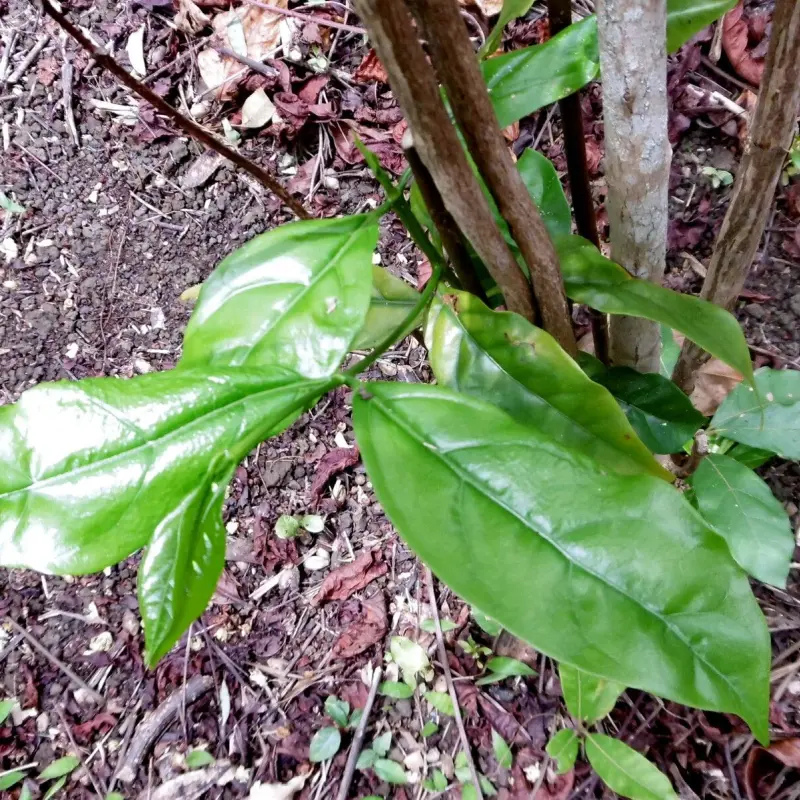 - Height: 22 feet- Cherry characteristics: Round-shaped and bright red with two seeds- Caffeine content: 1.08-1.83g/100g- **Sugar content: **33%- Flavor profile: Earthy but, sweeter than Robusta- Origin: the Congo, Oubangui, and Sangha rivers in Northern DRC, southern Congo Brazzaville and Central Africa Republic, and Southeastern Cameroon- Adopted/Growing region: the Congo, Oubangui, and Sangha rivers in Northern DRC, southern Congo Brazzaville and Central Africa Republic, and Southeastern Cameroon - Growing altitude: 1950-2650 feet- Growth period: 3 to 5 years- Crop-producing period: up to 50 years- Global market share: Unknown
- Height: 22 feet- Cherry characteristics: Round-shaped and bright red with two seeds- Caffeine content: 1.08-1.83g/100g- **Sugar content: **33%- Flavor profile: Earthy but, sweeter than Robusta- Origin: the Congo, Oubangui, and Sangha rivers in Northern DRC, southern Congo Brazzaville and Central Africa Republic, and Southeastern Cameroon- Adopted/Growing region: the Congo, Oubangui, and Sangha rivers in Northern DRC, southern Congo Brazzaville and Central Africa Republic, and Southeastern Cameroon - Growing altitude: 1950-2650 feet- Growth period: 3 to 5 years- Crop-producing period: up to 50 years- Global market share: Unknown
The Coffea congensis grows as a richly branched shrub to about 22 feet tall. Native to central Africa, you will find it along the Congo, Oubangui, and Sangha rivers in Northern DRC, southern Congo Brazzaville and Central Africa Republic, and Southeastern Cameroon.
Coffea congensis has the ability to withstand increased levels of rainfall. “Congensis comes from the Congo and grows naturally near rivers… the plant’s roots often grow in water,” Benoît Bertrand from CIRAD, a French agricultural research centre explains: “This could be interesting [and useful] in conditions where there is [heavy rainfall].”However, this coffee is not harvested for commercial purposes due to its low yield. Instead, it has been used before in interplanting programs to yield better versions of Coffea Canephora. Moreover, this wild coffee shrub grows in lowlands, primarily in wet forests and waterlogged areas.
10. Coffea Charrieriana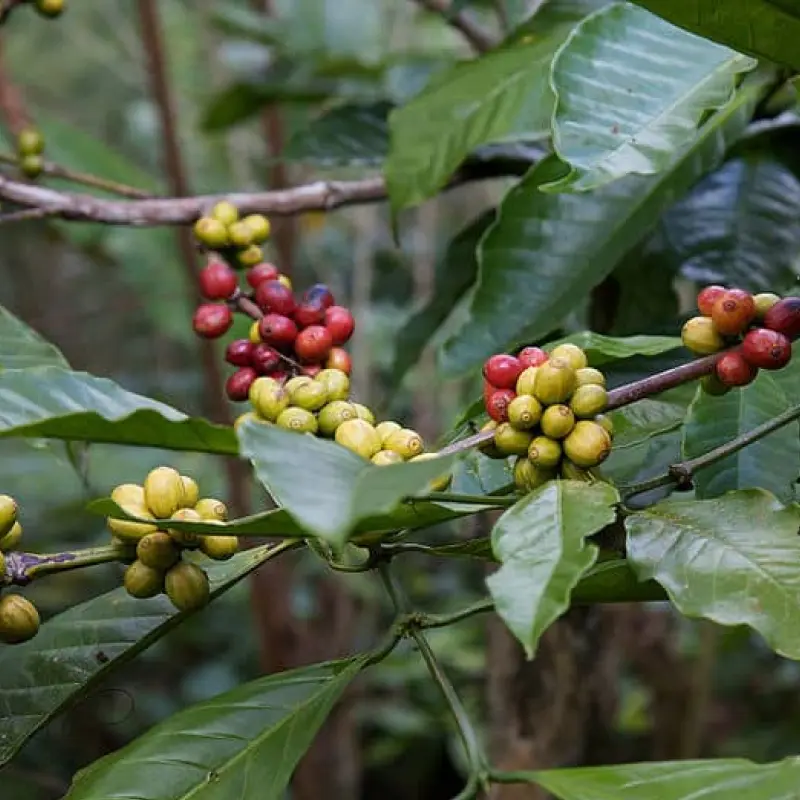 - Height: 3-5 feet- Cherry characteristics: Smooth elliptical small and red with two seeds- Caffeine content: 0g/100g- **Sugar content: **33%- **Flavor profile: **Sweet flavor with a fruity aroma- Origin: Cameroon- Adopted/Growing region: Cameroon and Costa Rica- Growing altitude: 525-1000 feet- Growth period: 4 to 5 years- Crop-producing period: Up to 10 years- Global market share: Unknown
- Height: 3-5 feet- Cherry characteristics: Smooth elliptical small and red with two seeds- Caffeine content: 0g/100g- **Sugar content: **33%- **Flavor profile: **Sweet flavor with a fruity aroma- Origin: Cameroon- Adopted/Growing region: Cameroon and Costa Rica- Growing altitude: 525-1000 feet- Growth period: 4 to 5 years- Crop-producing period: Up to 10 years- Global market share: Unknown
Coffea Charrieriana or Charrier coffee is a special coffee, the second recorded caffeine-free coffee plant, endemic to Cameroon. While it’s a native plant, charrier coffee was only discovered in 1983 by French researcher Adre Charrier, after which the plant is named.
It is also the very first caffeine-free coffee to grow in central Africa. The wild coffee plant grows in west Cameroon in the Bakossi Forest Reserve. It is a lowland species, growing at altitudes of 525 to 1000 feet, and doesn’t mind wet rainforest conditions on rocky slopes.
Its production is slowly picking up pace due to its value as a decaffeinated option. The coffee achieves its sweet taste and fruity aroma due to the zero caffeine content. But, its growth in Cameroon is threatened by the increased logging and palm oil production in the region.
11. Coffea Anthonyi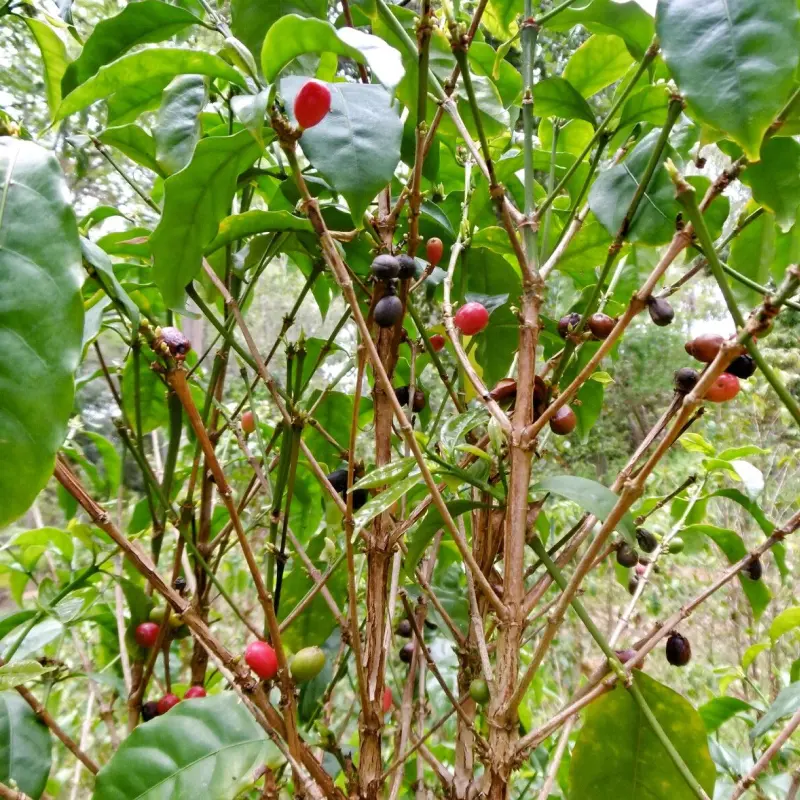 Coffea Anthonyi is a coffee tree type endemic to southeast Cameroon and northwest DRC. But, this coffee plant is not commercially cultivated. Instead, it is mostly grown for scientific research and cross-breeding. The self-compatible coffee is closely related to its relative, the Coffea Arabica plant.
Coffea Anthonyi is a coffee tree type endemic to southeast Cameroon and northwest DRC. But, this coffee plant is not commercially cultivated. Instead, it is mostly grown for scientific research and cross-breeding. The self-compatible coffee is closely related to its relative, the Coffea Arabica plant.
What makes these smaller, lesser-known Coffea plants is how they are closely related to the bigger and more popular varieties. It is believed that the Coffea Eugenioides variety descends from the Anthonyi variety. The Eugenioides variety blended with the Canephora plant to form the Coffea Arabica plant.
12. Coffea BrevidiscusBrevidiscus is a wild coffee tree native to sub-Saharan Africa. However, there’s not much information or studies on this type of wild coffee tree plant.
13. Coffea GallieniiThe Coffea Gallienii species is native to northern Madagascar. But, not much is known or recorded about this coffee species.
ConclusionIn total, there are over 100 different types of coffee trees. However, only a dozen of these species have been adequately studied, with the rest remaining as wild coffee species. Nonetheless, with the few existing studied species, there is still an exciting potential to learn more and explore the various interesting flavors they have.
It’s also interesting how the origin of most wild coffee plants further supports the fact that coffee originated from the African continent, particularly the sub-Saharan part of Africa. Moreover, learning more about these lesser known species can also help you better understand the origins, of even th emost commonly consumed coffee varieties.
If you have been indulging in Arabica and Robusta coffee alone, it’s time to expand your palate and try out other existing coffee varieties you can find on the market. You can find a handful of coffee roasters online that carry a reasonable variety of Coffea Excelsa, Liberica, and other rare varieties. As we continue to develop more interest in coffee, more research will be conducted to discover more potential coffee varieties.




